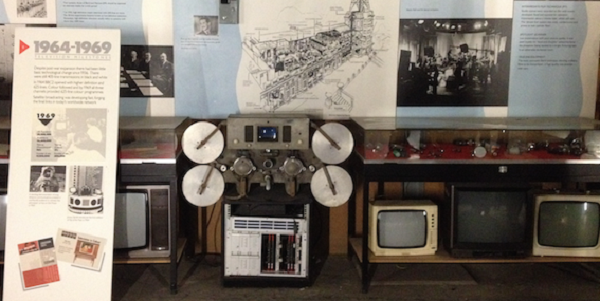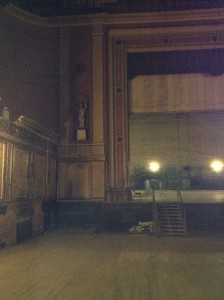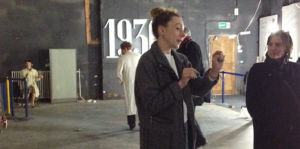
February 26, 2015, by Oliver Thomas
A visit to Ally Pally
Lynn Fotheringham gets to stand where Patrick Stewart played Oedipus!
Elena Theodorokopoulos, a classics lecturer at the University of Birmingham, has organised two screenings of televised productions of Greek tragedy at the Library of Birmingham this fortnight – two Oedipodes (1972 with Ian Holm; 1977 with Patrick Stewart – second half only) tonight, and a 1979 Agamemnon with Diana Rigg (The Serpent Son, with ‘modern satyr-play’, Of Mycenae and Men) next Thursday. Sadly I can’t go as I’m teaching until 6pm both evenings. Even though I saw the shows at the BFI in 2012 – and hope in future to bring them to Nottingham – I’m still disappointed: the delicious weirdness of The Serpent Son is something I can’t get enough of.
But what I got to do last week was perhaps even better. For the last three years, the ScreenPlays project at the University of Westminster has been creating a database of UK television productions of plays written for the theatre. The project is run by television producer and researcher John Wyver, who has been responsible for a number of film collaborations with the Royal Shakespeare Company, and classicist Amanda Wrigley, whose blogs about the screen-versions of Greek tragedy are linked to above; she also curated the 2012 BFI mini-season I mentioned. The project’s second conference was not only crammed with interesting people and papers, but actually held in Alexandra Palace, where the BBC studios were housed from 1936 to 1970, continuing in use after that date for BBC collaborations with the Open University.
 Ally Pally has had the green light from Haringey Council’s Planning Department for its historical restoration project, subject to final approval of the £18m application to the Heritage Lottery Fund. On Friday we got a tour of two disused areas hopefully soon to be restored: Studio A – where Patrick Stewart played Oedipus in half-mask and woolly wig, in a production aiming to capture the foreign flavour of Greek tragedy for students on the OU’s drama course; and the Victorian theatre. Among the delegates at the conference was Nick Levinson, formerly of the BBC/OU (and producer of one of very few UK TV versions of Greek comedy), who regaled us with tales of the time when the theatre-auditorium was used as a scenery-store, and he would walk to work through clouds of dust as unwanted scenery was broken into pieces for scrap, past fork-lift trucks bumping into the elegant doorways.
Ally Pally has had the green light from Haringey Council’s Planning Department for its historical restoration project, subject to final approval of the £18m application to the Heritage Lottery Fund. On Friday we got a tour of two disused areas hopefully soon to be restored: Studio A – where Patrick Stewart played Oedipus in half-mask and woolly wig, in a production aiming to capture the foreign flavour of Greek tragedy for students on the OU’s drama course; and the Victorian theatre. Among the delegates at the conference was Nick Levinson, formerly of the BBC/OU (and producer of one of very few UK TV versions of Greek comedy), who regaled us with tales of the time when the theatre-auditorium was used as a scenery-store, and he would walk to work through clouds of dust as unwanted scenery was broken into pieces for scrap, past fork-lift trucks bumping into the elegant doorways.
I took some rather grainy pictures with my iPhone in these dark spaces, and am very much looking forward to the time when they will again be open to the public – and in the case of the theatre, in use. Ally Pally will still need to raise £1.25m once the Lottery funding comes through – a great cultural cause if you want to chip in!
Images:
Top: mock museum-exhibit which will exist in the restored Studio A, with a cutaway diagram of Alexandra Palace and a variety of historic television sets.
Middle: The still-ornate but battered auditorium of the Victorian theatre, all seating removed. It reminded me of Pompeii, not only for the frozen-in-time feeling but also because the panelling and the red colour are popular in Roman interior decoration. Imagine seeing a 19th-century toga-play in these opulent, Classicising surroundings!
Bottom: Ally Pally’s Louise explains to a delegate how the restored Studio A will provide a museum experience showing visitors the television-making of the past. Behind her, a mocked up exhibit has dummies playing the parts of programme-makers. Based on the studio-plan for the 1977 Oedipus the King, Louise is standing roughly where Patrick Stewart delivered Oedipus’ great speech after blinding himself.
No comments yet, fill out a comment to be the first


Leave a Reply